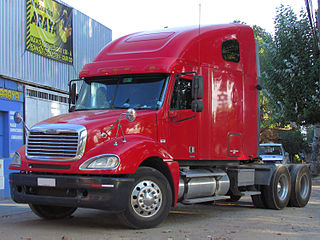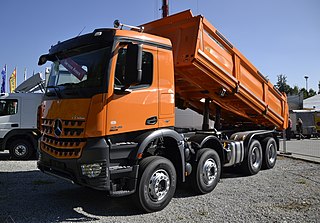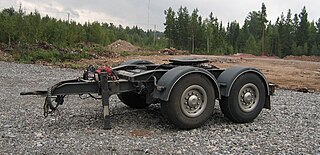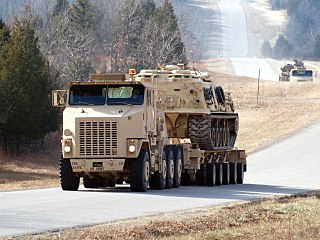
A semi-tractor-trailer truck is the combination of a tractor unit and one, or more, semi-trailers to carry freight. A semi-trailer attaches to the tractor with a type of hitch called a fifth-wheel.

A truck or lorry is a motor vehicle designed to transport cargo. Trucks vary greatly in size, power, and configuration. Smaller varieties may be mechanically similar to some automobiles. Commercial trucks can be very large and powerful and may be configured to be mounted with specialized equipment, such as in the case of refuse trucks, fire trucks, concrete mixers, and suction excavators. In American English, a commercial vehicle without a trailer or other articulation is formally a "straight truck" while one designed specifically to pull a trailer is not a truck but a "tractor".

A road train, land train or long combination vehicle is a trucking vehicle used to move road freight more efficiently than semi-trailer trucks. It consists of two or more trailers or semi-trailers hauled by a prime mover. Long combination vehicles are combinations of multiple trailers on tractor trucks as compared to standard 5 axle semi trailer-trucks with one trailer.

A tractor is an engineering vehicle specifically designed to deliver a high tractive effort at slow speeds, for the purposes of hauling a trailer or machinery such as that used in agriculture, mining or construction. Most commonly, the term is used to describe a farm vehicle that provides the power and traction to mechanize agricultural tasks, especially tillage, but nowadays a great variety of tasks. Agricultural implements may be towed behind or mounted on the tractor, and the tractor may also provide a source of power if the implement is mechanised.

An axle or axletree is a central shaft for a rotating wheel or gear. On wheeled vehicles, the axle may be fixed to the wheels, rotating with them, or fixed to the vehicle, with the wheels rotating around the axle. In the former case, bearings or bushings are provided at the mounting points where the axle is supported. In the latter case, a bearing or bushing sits inside a central hole in the wheel to allow the wheel or gear to rotate around the axle. Sometimes, especially on bicycles, the latter type axle is referred to as a spindle.

A railroad car, railcar, railway wagon, railway carriage, railway truck, railwagon, railcarriage or railtruck, also called a train car, train wagon, train carriage or train truck, is a vehicle used for the carrying of cargo or passengers on a rail transport system. Such cars, when coupled together and hauled by one or more locomotives, form a train. Alternatively, some passenger cars are self-propelled in which case they may be either single railcars or make up multiple units.

A trailer is an unpowered vehicle towed by a powered vehicle. It is commonly used for the transport of goods and materials.

A dump truck, known also as a dumper truck or tipper truck, is used for taking dumps for construction as well as coal. A typical dump truck is equipped with an open-box bed, which is hinged at the rear and equipped with hydraulic rams to lift the front, allowing the material in the bed to be deposited ("dumped") on the ground behind the truck at the site of delivery. In the UK, Australia and India the term applies to off-road construction plant only, and the road vehicle is known as a tipper lorry, tip-truck, tip-trailer, tipper truck, or tipper.

A tank truck, gas truck, fuel truck, or tanker truck or tanker, is a motor vehicle designed to carry liquids or gases on roads. The largest such vehicles are similar to railroad tank cars which are also designed to carry liquid loads. Many variants exist due to the wide variety of liquids that can be transported. Tank trucks tend to be large; they may be insulated or non-insulated; pressurized or non-pressurized; and designed for single or multiple loads. Some are semi-trailer trucks. They are difficult to drive and highly susceptible to rollover due to their high center of gravity, and potentially the free surface effect of liquids sloshing in a partially filled tank.

An electric multiple unit or EMU is a multiple-unit train consisting of self-propelled carriages using electricity as the motive power. An EMU requires no separate locomotive, as electric traction motors are incorporated within one or a number of the carriages. An EMU is usually formed of two or more semi-permanently coupled carriages, but electrically powered single-unit railcars are also generally classed as EMUs. The great majority of EMUs are passenger trains, but versions also exist for carrying parcels and mail.

A dolly is an unpowered vehicle designed for connection to a tractor unit, truck or prime mover vehicle with strong traction power.

A tractor unit is a characteristically heavy-duty towing engine that provides motive power for hauling a towed or trailered load. These fall into two categories: heavy and medium duty military and commercial rear-wheel drive semi-tractors used for hauling semi-trailers, and very heavy-duty typically off-road-capable, often 6×6, military and commercial tractor units, including ballast tractors.

A semi-trailer is a trailer without a front axle. In the United States, the term is also used to refer to the combination of a truck and a semi-trailer, a tractor-trailer.

The M54 5-ton 6×6 truck (G744) was the basic cargo model of the M39 Series truck. It was designed to transport a 10,000 lb (4,500 kg), 14-foot-long (4.3 m) cargo load off-road in all weather. In on-road service the load weight was doubled.
A specialized set of jargon describe the tools, equipment, and employment sectors used in the trucking industry in the United States. Some terms may be used within other English-speaking countries, or within the freight industry in general. For example, shore power is a term borrowed from shipping terminology, in which electrical power is transferred from shore to ship, instead of the ship relying upon idling its engines. Drawing power from land lines is more efficient than engine idling and eliminates localized air pollution. Another borrowed term is "landing gear", which refers to the legs which support the front end of a semi-trailer when it is not connected to a semi-truck. Some nicknames are obvious wordplay, such as "portable parking lot", in reference to a truck that carries automobiles.

A tank transporter is a combination of a heavy tractor unit and a mating full trailer or semi-trailer, used for transporting tanks and other AFVs. Some also function as tank recovery vehicles, the tractors of which may be armored for protection in combat conditions.
A liquid hydrogen trailer is a trailer designed to carry cryogenic liquid hydrogen (LH2) on roads being pulled by a powered vehicle. The largest such vehicles are similar to railroad tanktainers which are also designed to carry liquefied loads. Liquid hydrogen trailers tend to be large; they are insulated. Some are semi-trailers.

The Mack M123 (G792) was a 10-ton 6x6 semi-tractor introduced in 1955; the Mack M125 was a heavy cargo truck version of the M123. The M123 was used to tow tank transporter trailers while the M125 towed field artillery pieces.

The Oshkosh M1070 is a U.S. Army tank transporter tractor unit. In current service in A0 and A1 configurations, the M1070 is coupled to a DRS Technologies M1000 semi-trailer. The primary purpose of this combination is the transport of the M1 Abrams tank.
Vehicle weight is a measurement of wheeled motor vehicles; either an actual measured weight of the vehicle under defined conditions or a gross weight rating for its weight carrying capacity.

















